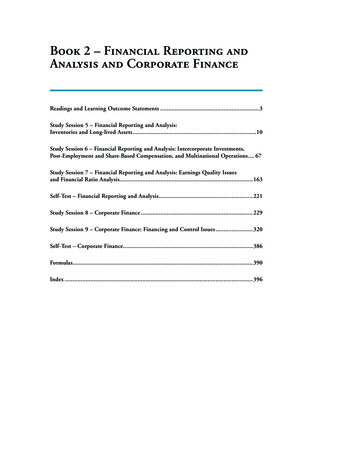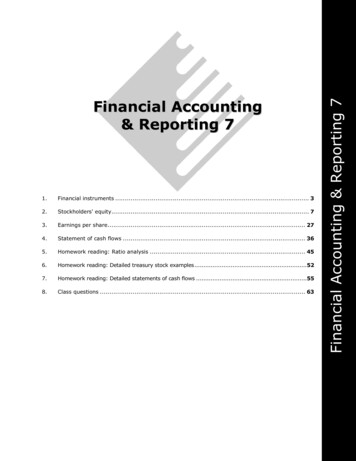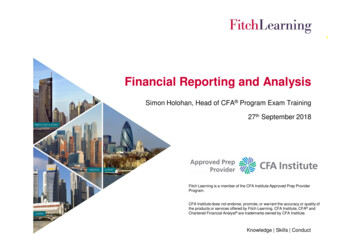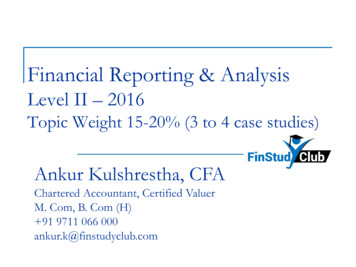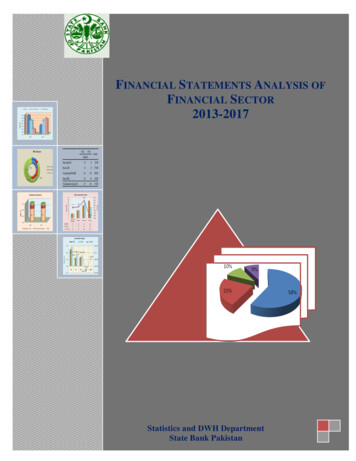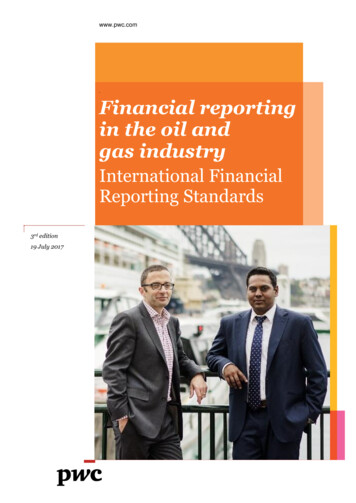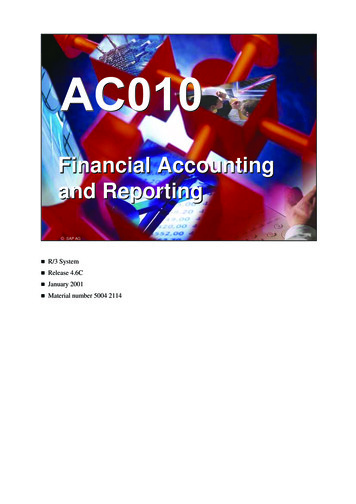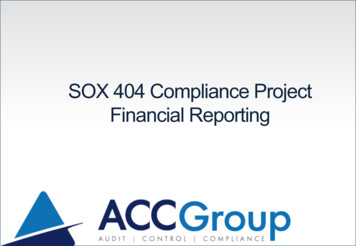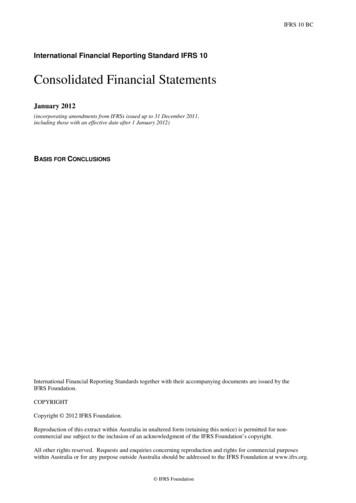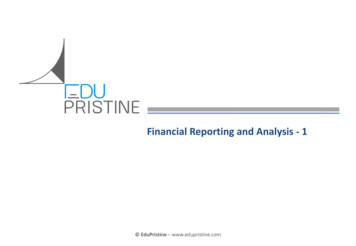
Transcription
Financial Reporting and Analysis - 1 EduPristine CFA - Level – I (FRA-I) EduPristine – www.edupristine.com
Mapping to Curriculum Reading 22: Financial Reporting and Analysis: An Introduction Reading 23: Financial Reporting Mechanics Reading 24: Financial Reporting Standards Reading 25: Understanding Income Statements EduPristine CFA - Level – I (FRA-I)Post your Queries at our Forum1
Financial Reporting and Analysis(Study session 7 – Reading 22) EduPristine CFA - Level – I (FRA-I)Post your Queries at our Forum2
Coverage for Reading 22 - FSA: An Introduction1. Role of Financial reporting and Financial Statement Analysis (FSA)2. System of Double Entry3. Steps in FSA framework4. Audit of financial statements5. Internal Controls in an organisation6. Basic Accounting Principles EduPristine CFA - Level – I (FRA-I)Post your Queries at our Forum3
Sequence of actions in business and its reporting1 Business Transaction2 Recording for future referenceAccounting(Journals, Ledgers, Memo)3 Proper presentationFinancial Reporting(Balance sheet, P/L, Cash Flow St)4 Use of information by stakeholder EduPristine CFA - Level – I (FRA-I)Financial Statement AnalysisPost your Queries at our Forum4
Roles of Financial reporting and Financial Statement Analysis Financial reporting: It is the way companies show their performance to outside world. International Accounting Standards Board (IASB) has described the role of financial reporting in itsFramework for the Preparation & Presentation of Financial Statements as:“ The objective of financial statements is to provide information about the financial position,performance and changes in financial position of an entity that is useful to a wide range of users inmaking economic decisions”. Financial Statement Analysis (FSA): The role of FSA is to use the company’s financial statements &other relevant information to make economic decisionsa) FSA is used to1. Evaluate company’s past performance and current financial position2. Project company’s ability to earn profits and future cash flowsb) So that economic decisions like the following can be taken:1. Whether to invest in the company's securities2. Whether to extend bank credit to the company EduPristine CFA - Level – I (FRA-I)Post your Queries at our Forum5
Flow of information in an accounting systemJournal entries1(record every transaction chronologically)2General ledger(sorts the entries in the general journal by accounts)3Trial balance(initial trial balance & adjusted trial balance)4Financial statement(Grouping into various financial line items) EduPristine CFA - Level – I (FRA-I)Post your Queries at our Forum6
Double entry accountingEach transaction is recorded atleast at two (double) accounts and in a way that balances both thesides of the balance sheet.For example:A. An increase in an asset account must be balanced by either: Increase in a liability or owners' equity account. Decrease in another asset account.B. An expenses incurred (causing reduced earning leading to low retained earning to low equityhence lower liability) must be balanced by either: Reduction in cash (if expenses is incurred in cash). Increase in liability (if expenses is incurred on credit).Account 1Account 2ExampleAsset Asset Purchase inventory with cashAsset Liability Purchase inventory on creditAsset Equity Company pays out Salary EduPristine CFA - Level – I (FRA-I)Post your Queries at our Forum7
Examples on Double entry accounting1. Purchase furniture for 1,000 cash Furniture (an asset) increases by 1,000.Cash (an asset) decreases by 1,000.Both assets and liabilities are balanced.Both assets and liabilities are balanced.2. Purchase furniture for 1,000 through raising 1,000 notes Furniture (an asset) increases by 1,000. Notes (liability) increases by 1,000. Both assets and liabilities are balanced.3. Pay 1000 for salary in cash Salary (expenses) reduces net income, leading to low equity and lower liabilities by 1000. Cash reduces by 1000. Both assets and liabilities are balanced. EduPristine CFA - Level – I (FRA-I)Post your Queries at our Forum8
Two types of authorities in each country1. Standard-setting bodies: professional organizations of accountants & auditors that establishfinancial reporting standards.2. Regulatory authorities: government agencies that have the legal authority to enforce compliancewith the reporting standards. Most national regulators are members of International Organization of Securities Commissions(IOSCO). IOSCO has three objectives:1. Protect Investors.2. Ensure fairness, efficiency & transparency.3. Reduce systemic risk . IOSCO goal is to bring uniformity in financial regulation across countries. IOSCO does not have legally enforceable power. EduPristine CFA - Level – I (FRA-I)Post your Queries at our Forum9
Structure of FSA1. Determinethe Objectiveand Context2. Gather Data6. Updatethe Analysis3. Process the Data5. Report theConclusions orRecommendations EduPristine CFA - Level – I (FRA-I)4. Analyze andinterpret the dataPost your Queries at our Forum10
Stating the context or objective of AnalysisStakeholderObjectiveLenderCredit worthinessInvestorReturns from the investmentSupplierLiquidity PositionCustomerSustainability of operationsCapital MarketsCorporate GovernanceGovernmentRevenue generation abilityEmployeesImpact on wages/salaries EduPristine CFA - Level – I (FRA-I)Post your Queries at our Forum11
Sources of information for an analyst1. Financial statements2. Supplementary information3. Footnotes4. Management Disclosure and Analysis5. SEC filings6. Proxy Statements7. Other Sources EduPristine CFA - Level – I (FRA-I)Post your Queries at our Forum12
1. Financial Statements Are the different formats which have been prescribed by the law (accountancy) to be used for thepurpose of financial reporting. Each format communicates a separate aspect of the business Different Financial Statements are: Income Statements Balance Sheet Cash Flow Statement of change in owner’s equity EduPristine CFA - Level – I (FRA-I)Post your Queries at our Forum13
2. Supplementary schedules These schedules detail out different consolidated figures given in financial statements. These are more or less voluntary disclosures by the company. Supplementary schedules contains additional information like:1. Operating income or sales by region or business segment2. Reserves for an oil and gas company3. Information about hedging activities and financial instruments Supplementary schedules are not required to be audited EduPristine CFA - Level – I (FRA-I)Post your Queries at our Forum14
3. Financial Statement NotesAlso known as FOOTNOTES: Provides information about accounting methods, assumptions & estimates used in preparingfinancial statements Provide additional information on business segment, related party transactions, acquisitions /disposals, contingencies, significant customers Allows users to improve their assessment of amount, timing & uncertainty of estimates reportedin financial statements All footnotes are required to be auditedCompany ACompany BRevenue100600Revenue through related party5000Total Revenue600600Since Company A has many related party transactions, company B’s revenues are morereliable EduPristine CFA - Level – I (FRA-I)Post your Queries at our Forum15
4. Management's Discussion and Analysis (MD&A) Management's Discussion and Analysis (MD&A) provides assessment of the financial performanceof a firm from management’s perspective1. In the US, public companies are required to disclose following information in MD&Aa)b)c)d)Result from operations with trends in sales and expenseGeneral business overview based on known trendsCapital resources and liquidity along with trends in cash flowsDiscussion on significant events & uncertainties2. Additional information, not compulsorily required to be disclosed, under MD&A:a)b)c)d)Effects of known trends on businessAccounting policies requiring significant judgmentIssues related to capital structure and liquidityInformation on unusual or infrequent items and extraordinary items etc. Qualitative business performance Significant effects of currently known trends, events Risks facing the organizations Outlook EduPristine CFA - Level – I (FRA-I)Post your Queries at our Forum16
5. Different SEC FilingsForm S-1To be memorized Registration statement filed prior to the sale of new securities to the public.Form 10-K Disclosure about business and its management , audited financial statements, legal matters etc. 40-F: corresponding form for Canadian companies listed on US exchanges 20-F: corresponding form for foreign issuers listed on US exchangesForm 10-Q Quarterly Report: Financial statements may not be audited (but will be reviewed by auditors)6-K Non-U.S. companies file for semiannual financial report EduPristine CFA - Level – I (FRA-I)Post your Queries at our Forum17
5. Different SEC Filings (Contd.)Form 8-KTo be memorized Filed to disclose material event like: Acquisitions and disposals Changes in management or corporate governance Accountants, financial statements, or other related matters Press ReleasesForm DEF-14A: Proxy statement for its shareholders (prior to the annual meeting or other shareholder vote).Form 144: When a company issues securities to certain Qualified Institutional Buyers (QIB) withoutregistering the securities with the SEC.Form 3,4,5 Details on beneficial ownership of securities by company's officers and directors. Can learn about purchases and sales of company securities by corporate insiders. EduPristine CFA - Level – I (FRA-I)Post your Queries at our Forum18
6. Proxy Statements It is a form to be used for voting in the absence of shareholder from the AGM. Issued to shareholders along with the notice of AGM highlighting the decisions that needshareholder’s approval like:a) Appointment of a directorb) Appointment of an auditorc) Any M&A to be done Good source of information about the election of (and qualifications of) board members.compensation, management qualifications, and the issuance of stock options and sales ofcompany securities by corporate insiders. EduPristine CFA - Level – I (FRA-I)Post your Queries at our Forum19
7. Other Sources of Informationa) Corporate Reportsb) Press Releasesc) Trade Journalsd) Statistical Reporting Services and Govt. Agencies EduPristine CFA - Level – I (FRA-I)Post your Queries at our Forum20
Audit of Financial StatementsAuditor: an accounting expert appointed by shareholders to independently review the FS preparedby the management. Every country’s regulatory body prescribes the minimum qualification that is required for anauditors. Attestation function – signing and certification that the FS are free from material errors.Objective of Audit To get an independent opinion on fairness and reliability of financial statements. To check whether generally accepted accounting policies (GAAP) were followed. To examine efficiency of accounting & internal control system. To determine financial statements contain no material errors.Audit reports to the shareholders and NOT to the management. Audit report is addressed to the shareholders and NOT to the management.Auditor is not a BLOODHOUND. He is just a WATCH DOG. He has responsibility to reasonably assure the stakeholders about the fairness of FS. Different accounting fraud has led to a debate on the role and responsibility of the auditor. EduPristine CFA - Level – I (FRA-I)Post your Queries at our Forum21
Audit Reports – Types of ScenariosOn the basis of his analysis, an auditor can issue one of the following 4 reports:1. Unqualified opinion FS are free from material omissions and errors. FS reflect the true and fair picture of the business.2. Qualified Opinion Except for few material issues, FS reflect the true and fair picture of the business. Above material issues do not change the overall message communicated by the FS. Auditors must explain these exceptions in the audit report.3. Adverse Opinion Statements DO NOT represent the true and fair picture. There are material omissions / errors.4. Disclaimer of Opinion Due to some circumstances, an audit is unable to express any opinion on the FS, he issues adisclaimer. Disclaimer DOES NOT mean that FS are incorrectly prepared by the management. Disclaimer is Inability of expression. EduPristine CFA - Level – I (FRA-I)Post your Queries at our Forum22
4 elements of a standard report1. FS preparation is responsibility of management2. Accounting standards has been followed and there is reasonable assurance that FS are free frommaterial errors3. Accounting estimates and principles used in FS preparation are reasonable4. Auditor’s Comment on the internal controls in the organisation EduPristine CFA - Level – I (FRA-I)Post your Queries at our Forum23
Auditor’s Report – Explanatory paragraph Auditor’s report contain explanatory paragraph when material loss is probable but the amountcan’t be reasonable ascertained Uncertainties are caused due to issues related to:1. Going concern assumptions2. Any litigation3. Realization of assets values For example, in the case of British Petroleum oil spill, the auditor would include an explanatoryparagraph on the material loss EduPristine CFA - Level – I (FRA-I)Post your Queries at our Forum24
Internal controls Internal controls are checks and balances implemented by the management which ensures thatcompany uses a proper process to prepare and present accurate financial statements Auditor is part of review mechanism – It is MGT’s primary responsibility to ensure that fraud does nothappen. US GAAP requires auditor to comment on internal controls implemented by company: Management is required to provide a report on internal control system under the Sarbanes –Oxley Act that: Management is responsible for maintain
making economic decisions”. Financial Statement Analysis (FSA): The role of FSA is to use the company’s financial statements & other relevant information to make economic decisions. a) FSA is used to. 1. Evaluate company’s past performance and current financial position 2.
